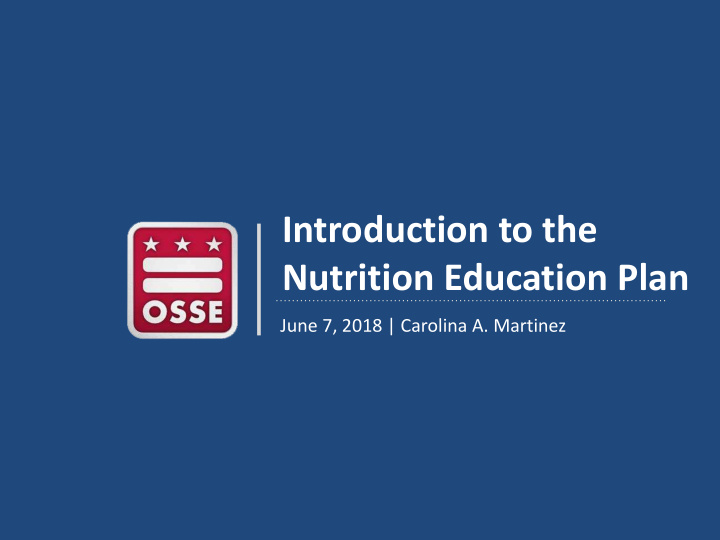



Introduction to the Nutrition Education Plan June 7, 2018 | Carolina A. Martinez
About Me Office of the State Superintendent of Education (OSSE) Carolina A. Martinez, MS, RDN, LD Nutrition Education Specialist Division of Health & Wellness Healthy Schools and Wellness Programs Team 2
Agenda • About the Plan • Using the Plan • Obtaining Support 3
About the Plan
Nutrition Education Plan • Guide that will be used by the Office of the State Superintendent of Education (OSSE) when developing nutrition education related programming for schools and providing technical assistance • Those working in nutrition education in the District are strongly encouraged to fulfill and/or participate in the actions outlined within the plan 5
Importance of Nutrition Education • Helps students maintain a healthy weight • Establishes healthy eating behaviors • Enhances classroom engagement • Promotes an overall healthier lifestyle • 12 percent of high school students ate vegetables at least three times in the previous week (down from 15 percent in 2012) 1 • Healthier students are better learners 2 1) DC Youth Risk Behavior Survey (2015). Retrieved from http://osse.dc.gov/service/dc-youth-risk-behavior-survey-yrbs 2) Charles E. Basch. (2010). Healthier students are better learners: A missing link in school reforms to close the achievement gap. Retrieved from http://www.equitycampaign.org/i/a/document/12557_EquityMattersVol6_Web03082010.pdf 6
Importance of Nutrition Education 3 (Cont. ) Skipping Deficits of breakfast specific nutrients Lack of consumption of Lower specific foods, Lower Higher cognitive like grades absenteeism performance fruits, vegetables, or dairy products Hunger due to insufficient food intake 3) Centers for Disease Control and Prevention. (2014). Health and Academic Achievement. Retrieved from 7 https://www.cdc.gov/healthyyouth/health_and_academics/pdf/health-academic-achievement.pdf
Nutrition and the Whole Child Whole School Whole Community Whole Child (WSCC) Model 4 • Created by the Centers for Disease Control and Prevention Healthier students are better learners! 2 2) Charles E. Basch. (2010). Healthier students are better learners: A missing link in school reforms to close the achievement gap. Retrieved from http://www.equitycampaign.org/i/a/document/12557_EquityMattersVol6_Web03082010.pdf 8 4) Centers for Disease Control and Prevention. Whole School, Whole Child, Whole Community Model. (2014). Retrieved from https://www.cdc.gov/healthyyouth/wscc/
Goals 1. Students receive age-appropriate, evidence-based nutrition education that promotes positive dietary behavior changes WSCC Component: Health Education 2. Schools implement policies and practices to create a nutrition environment that supports students in making healthy choices WSCC Component: Nutrition Environment and Services 9
Goals (Cont.) 3. Partnerships between community groups, organizations, and local businesses and OSSE, relevant District agencies, and/or schools are created to share resources, and support student learning, development, and health-related activities WSCC Components: Community Involvement; Physical Education and Physical Activity 4. Parents/guardians are engaged and actively support student learning around nutrition, their development as it relates to the consumption of proper nutrition, and their overall health WSCC Component: Parent Engagement 10
Goals (Cont.) 5. Schools foster physically and mentally healthy employees fit to support students’ nutritional needs, overall health and academic success WSCC Components: Employee Wellness 6. Schools offer a healthy, safe, and supportive social and emotional climate and physical environment, and has the necessary health, counseling, psychological, and social services to support students’ development, health, and learning (bullying (related to food consumption); eating disorders; clean drinking water; allergy management; chronic disease management) WSCC Components: Social and Emotional Climate; Physical Environment; Health Services; Counseling, Psychological, and Social Services 11
Desired Outcomes Enhanced student nutrition knowledge Improved Healthier academic Goals students performance Enhanced consumption of healthy foods 12
Development of the Nutrition Education Plan 1. Needs assessment – Focus groups – One-on-one interviews – Survey 2. Inquiries with other districts/states 3. Stakeholder input – Nutrition Education Plan Workgroup – Round table at the Health and Wellness Symposium 13
Measuring the Impact of the Nutrition Education Plan Student Health Knowledge (HPEA) Student School Health Resources Behaviors (SHP) (YRBS) Improved Student Outcomes 14
Using the Plan
Uses Do you want to… Check out… Learn about the overarching goals of the The goals and objectives on page 6. Nutrition Education Plan? Know how you can contribute to making the The section for your audience. goals of the plan a reality? Become familiar with OSSE’s nutrition The OSSE Resources section on page 24. education resources? Read about nutrition education best The Best Practices section on page 22. practices? Focus on top resources for nutrition The “Top Items Checklists” at the start of education?” each audience’s section. Receive support around using the plan? Contact the Healthy Schools and Wellness Programs team at OSSE.Hydt@dc.gov. 16
Audiences • The plan has been broken down into resources for: – Early Child Care Education Centers – LEA/School Staff • Administrative • Educators • Foodservice staff – Student families – Those working in nutrition education in the District 17
One Pagers 18
Section: Getting Involved As A… • Sections outline actions that each audience can take to contribute to the goals of the plan • For example, as a member of the food service staff team, you can: 1. Work towards quality nutrition education by: • Telling students about the benefits of school meals or specific items in the menu. 19
Appendices • I: Nutrition Education Best Practices • II: Transition Best Practices • III: Resources 20
Obtaining Support
Technical Assistance • Technical assistance on implementation of the Nutrition Education Plan and its actions is available – Place a request through the Healthy Schools and Wellness Program’s Technical Assistance Request Form • Website: https://osse.dc.gov/node/1334246 22
Q&A
Thank you!
Recommend
More recommend